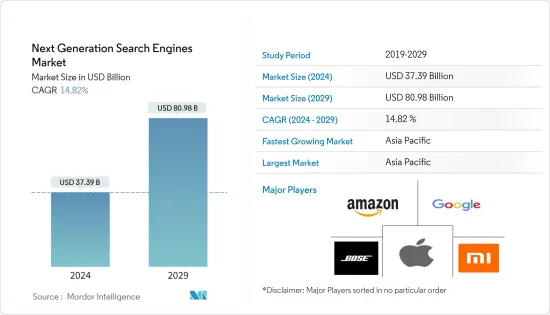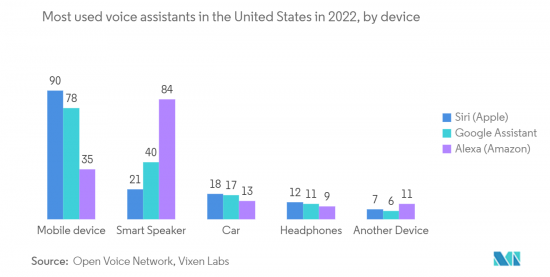 |
市場調查報告書
商品編碼
1403133
下一代搜尋引擎:市場佔有率分析、產業趨勢與統計、2024年至2029年成長預測Next Generation Search Engines - Market Share Analysis, Industry Trends & Statistics, Growth Forecasts 2024 - 2029 |
||||||
※ 本網頁內容可能與最新版本有所差異。詳細情況請與我們聯繫。
下一代搜尋引擎市場規模預計到 2024 年為 373.9 億美元,預計到 2029 年將達到 809.8 億美元,在預測期內(2024-2029 年)複合年成長率為 14.82%。

主要亮點
- 下一代搜尋引擎為想要獲得有關搜尋的工作知識以評估可用解決方案並與軟體和資料提供者互動的決策者和科學家提供先進的資訊搜尋模型。近年來,語音搜尋的數量呈指數級成長。此外,語音搜尋不再是新鮮事物,而是正在成為新標準。因此,下一代搜尋引擎面向基於語音的搜尋引擎。
- 下一代搜尋引擎的成長也得益於人工智慧技術的進步,例如深度神經網路和機器學習。智慧揚聲器等虛擬助理被用於多個終端用戶行業的各種應用,包括零售、BFSI 和醫療保健。消費者的主要應用之一是個人助理。這可以幫助消費者完成多項任務。例如,Apple 的 Siri 為連網家庭和汽車提供了直覺的介面。
- 對自助服務選項不斷成長的需求反映了消費者對更快速度和便利性的快速成長的需求。根據 NICE 的 2022 年數位第一客戶體驗報告,81% 的消費者表示他們想要更多的自助服務選擇。然而,只有 15% 的消費者對所提供的工具非常滿意。這一趨勢正在推動下一代搜尋引擎市場的需求。
- 對改善專業服務客戶體驗的日益關注正在推動市場發展。改善客戶體驗帶來豐厚回報。無論哪個行業,滿意的客戶都會花更多的錢並隨著時間的推移保持忠誠度。透過同情客戶並幫助他們解決問題,這些公司可以釋放巨大的價值來源,發現新的商機,並從長遠來看改變他們的商業模式。
- 對真人互動的日益偏好可能會抑制市場。根據 Liveperson Inc. 進行的一項研究,全球 87% 的消費者更喜歡那些能夠透過語音和訊息傳遞與他們進行靈活互動的公司。這些偏好會根據情況和一天中的時間而變化,因此它顯示了允許消費者在他們想要的時間、地點、條件下使用服務的重要性。
- COVID-19大流行對市場產生了負面影響。由於嚴格的政府法規迫使人們留在家裡,智慧型手機已成為娛樂和其他用途的資訊來源。因此,語音辨識和語音搜尋技術的進步增加了語音搜尋行動化的趨勢。隨著公司尋求以區域語言建立語音援助,這種趨勢持續成長,我們預測市場在未來幾年只會成長。谷歌聲稱正確說英語的準確率高達 95%。此外,智慧型手機上的 Google 語音搜尋支援 60 多種語言。
下一代搜尋引擎市場趨勢
自助服務和個人細分市場將經歷最高的成長
- 面向個人最終用戶的智慧音箱預計將佔據大部分市場佔有率。我們現在期望智慧揚聲器具備的一些功能包括播放音樂和透過可以立即回答任何問題的語音助理控制智慧家庭設備。
- 消費者應用開發中的技術進步導致了智慧或連網家庭的整合。智慧家庭的發展導致最終用戶將行動網際網路和高速寬頻連接部署到市場上的每個家庭。
- 聲控音箱已經成為人們日常生活的一部分。音訊揚聲器提供了在多任務處理時使用技術的能力。個人化答案是語音搜尋的著名使用案例之一,Google已經達到了顯著的程度,因為它知道並且可以猜測用戶接下來會問什麼問題。另一方面,Alexa 無法像 Google 一樣理解上下文。雖然 Alexa 依賴自訂的技能和協議,但 Google Assistant 可以理解特定的使用者請求並提供更個人化的回應。
- 語音使用者依靠助理來完成購買過程中的許多任務,包括產品研究、價格比較和添加到購物車。 Adobe 研究表明,消費者在整個購物過程中都使用語音。前三名的活動是產品研究/研究 (47%)、建立購物清單 (43%) 和價格比較 (32%)。
- 最著名的智慧音箱是 Amazon Echo 和 Google Nest 系列,但也有一些第三方音箱,例如 Sonos One,內建了 Alexa 和 Google Assistant。
- 美國仍然是消費領域的重要市場,特別是在語音助理的普及。根據 eMarketer 的數據,過去 5 年來,語音助理的數量已從 1.03 億增加到 1.23 億。根據 NPR 最新的智慧音訊報告,18 歲以上的美國人中有 24% 擁有至少一台智慧音箱。平均業主擁有不只一個。超過一半的美國人擁有 Alexa。自從亞馬遜首次推出 Echo 以來,它在美國廣受歡迎,並不斷挑戰頂級競爭。

亞太地區佔最大市場佔有率佔有率
- 目前,亞太地區在所研究的市場中佔據最大的市場佔有率。該地區,特別是新興國家的產品需求預計將保持在較高水準。預計主要企業將主要關注該地區並瞄準年輕人。
- 中國、印度、日本、韓國和新加坡等具有消費產品需求的人口大國預計將繼續成為目標市場,因為這些國家的產品需求將繼續推動市場。
- 此外,電子商務在中國和印度等國家/地區不斷發展,預計將推動線上配銷通路銷售智慧設備。例如,根據 IBEF 預測,到 2026 年,印度的電子商務市場預計將成長至 2,000 億美元。該行業的發展受到網際網路和智慧型手機日益普及的推動。
- 最新的行銷趨勢是企業實施語音搜尋引擎最佳化以吸引潛在的入境流量。例如,中國的科大訊飛擁有準確率高達98%的語音辨識系統。該系統準確地將英語翻譯成普通話,普通話翻譯成英語、韓語、日語和22種不同的中國方言。該公司團隊預計三年內準確率將達到 99%。
- 預計該地區的主要供應商還將透過提供不同價位的產品來瞄準對價格敏感的消費群組。這為低價提供產品的供應商創造了機會。擁有昂貴產品的供應商可能會透過提供可與其他電子產品(例如筆記型電腦或平板電腦)配合使用的產品來瞄準不同的客戶群。
下一代搜尋引擎產業概述
市場競爭激烈,主要以技術創新為關鍵成長要素。它對亞馬遜、谷歌和蘋果等行業領導者保持著適度的集中度。最近出現了一些值得注意的進展。
2023 年 5 月,Google宣布計劃推出人工智慧整合搜尋引擎結果頁面。這個創新的搜尋引擎目前正在階段中,其特點是人工智慧生成的主題摘要顯示在傳統搜尋結果上方。它還包括突出顯示的背景部分,其顏色根據用戶的搜尋意圖動態調整。
2022年9月,Z世代與TikTok建立策略夥伴關係,推出新的搜尋引擎。此次合作利用 TikTok 強大的演算法,有效契合年輕用戶的偏好。值得注意的是,該搜尋引擎的與眾不同之處在於,它提供由平台上真實個人而不是匿名網站合成和分發的內容。
其他福利:
- Excel 格式的市場預測 (ME) 表
- 3 個月的分析師支持
目錄
第1章簡介
- 研究假設和市場定義
- 調查範圍
第2章調查方法
第3章執行摘要
第4章市場洞察
- 市場概況
- 產業吸引力-波特五力分析
- 新進入者的威脅
- 買家/消費者的議價能力
- 供應商的議價能力
- 替代品的威脅
- 競爭公司之間敵對關係的強度
- COVID-19 對下一代搜尋引擎市場的影響
第5章市場動態
- 市場動態介紹
- 市場促進因素
- 更加重視改善專業服務的客戶體驗
- 自助服務和個人細分市場將經歷最高的成長
- 市場抑制因素
- 越來越偏好與真人對話
第6章市場區隔
- 按配銷通路
- 線上的
- 離線
- 按最終用戶
- 個人
- 商業的
- 按地區
- 北美洲
- 歐洲
- 亞太地區
- 拉丁美洲
- 中東/非洲
第7章競爭形勢
- 公司簡介
- Amazon.com Inc.
- Google LLC(Alphabet Inc.)
- Alibaba Group
- Sonos Inc.
- Harman-Kardon Inc./JBL
- Apple Inc.
- Bose Corporation
- Xiaomi Inc.
- Baidu Inc.
第8章投資分析
第9章 市場機會及未來趨勢

The Next Generation Search Engines Market size is estimated at USD 37.39 billion in 2024, and is expected to reach USD 80.98 billion by 2029, growing at a CAGR of 14.82% during the forecast period (2024-2029).
Key Highlights
- The next-generation search engine provides an advanced information retrieval model for decision-makers and scientists who wish to gain working knowledge about the search to evaluate available solutions and dialogue with software and data providers. Over the last few years, the number of voice searches has increased exponentially. Also, it is becoming less of a novelty and more like a new standard. Therefore, the next-generation search engines are more oriented toward voice-based search engines.
- Next-generation search engines are also increasing because of deep neural networks, machine learning, and other advancements in AI technologies. Virtual assistants, such as smart speakers, are used for various applications across several end-user industries, such as retail, BFSI, and healthcare. One primary consumer-facing application is a personal assistant. It helps consumers accomplish multiple tasks. For instance, Apple's Siri offers an intuitive interface for connected homes or cars.
- Growing demand for Self-service options indicates rapid growth in consumer demand for more incredible speed and convenience. According to NICE's 2022 Digital First Customer Experience Report, 81% of consumers say they want more self-service options. Yet, only 15% of consumers expressed high satisfaction with the tools provided to them. This trend drives the demand for Next next-generation search engine market.
- Increasing focus on improving Customer Experience across professional services drives the market. Enhancing the customer experience can bring rich rewards. Across industries, satisfied customers spend more and stay more loyal over time. By showing empathy with customers and helping to fix their problems, companies like these can tap into a source of tremendous value, find new business opportunities, and shift their operating model over time.
- Increasing Preference for Live Person Interaction could restrain the market. According to a survey conducted by Liveperson Inc., 87% of consumers worldwide prefer that the companies provide the flexibility to connect interactions across voice and messaging. Such preferences also shift based on different situations and times of the day, demonstrating the importance of allowing consumers to engage on their terms, when, and where they want.
- The COVID-19 pandemic had a negative impact on the market. Stringent government regulations that required people to stay at home made smartphones a primary source of entertainment and other purposes. As a result, the voice search mobility trend increased with advancements in speech recognition and voice search technology. This trend continues to grow, and companies are trying to build voice assistance in regional languages, which predicts that the market will rise steadily over the next few years. Google has a 95% accuracy rate when spoken correctly in English. Moreover, Google Voice Search on smartphones is available in over 60 languages.
Next Generation Search Engines Market Trends
Self Service and Personal Segment to Witness the Highest Growth
- Smart speakers in personal end-user verticals are expected to hold the majority share. The characteristics expected from a smart speaker nowadays include playing music and controlling smart home devices consisting of voice assistants ready to answer every question.
- The technological enhancements in the development of consumer applications resulted in the integration of smart homes or connected homes. Smart homes' development pushed end users to adopt mobile internet and fast broadband connections across households in the market.
- Voice-activated speakers have become part of people's routines. They provide the ability to use the technology while multi-tasking, as people speak more quickly than they can type (speed), and the increasingly "human" interfaces. Personalized responses are one of the famous use cases of voice search, which Google has attained to a large extent, as Google can know and guess the next question the users will most likely ask. On the other hand, Alexa cannot understand the context to the same extent as Google. Alexa relies on custom-built skills and protocols, whereas Google Assistant can understand specific user requests and further personalize the response.
- Voice users turn to their assistants to accomplish many tasks along their buying journeys, such as product research, price comparison, and adding to cart. A study from Adobe announced the consumer's usage of voice throughout their shopping journeys. The top three activities included product search/research (47%), creating shopping lists (43%), and price comparison (32%).
- The most well-known smart speakers are the Amazon Echo and Google Nest range of products, but there are plenty of third-party speakers, like the Sonos One, which comes with both Alexa and Google Assistant built-in.
- The United States remains a key market for the personal segment, especially voice assistant adoption. According to eMarketer, The number of voice assistants has risen from 103 million to 123 million over the last five years. According to the latest Smart Audio Report from NPR, 24% of Americans aged 18 years or above own at least one smart speaker. The average owner has more than one. A majority of Americans own Alexa. Since Amazon first introduced the Echo, it has become popular in the United States, and it continues to challenge top competitors.

Asia-Pacific Occupies the Largest Market Share
- The Asia-Pacific region currently holds the largest market share for the market studied. The demand for the products in the region, which is primarily from emerging economies, is expected to remain high. The major players are expected to focus chiefly on this region, with the youth as the target audience.
- China, India, Japan, South Korea, Singapore, and other populous nations with consumer product-based demand are expected to remain the target market as product demand in these countries continues to drive the market.
- Moreover, the growth of e-commerce across the world in countries like China and India is anticipated to drive the online distribution channels for selling smart devices. For instance, according to IBEF, the Indian e-commerce market is expected to grow to USD 200 billion by 2026. The development of the industry is driven by increasing internet and smartphone penetration.
- The latest marketing trend is companies implementing voice SEO to attract possible inbound traffic. For instance, China's iFlytek has a speech recognition system with an accuracy rate of 98%. The system accurately translates English to Mandarin and Mandarin to English, Korean, Japanese, and 22 different Chinese dialects. Its team predicts that it will achieve 99% accuracy within three years.
- Also, the major vendors in this region are expected to target the price-sensitive consumer group by offering products in different price segments. Therefore, they create an opportunity for vendors who offer products at a low price. Vendors with expensive products may target a different customer segment by offering products as a package in collaboration with other electronic products, such as notebooks and tablets.
Next Generation Search Engines Industry Overview
The market faces intense competition, primarily driven by technological innovation as a pivotal growth factor. It maintains a moderate level of concentration, featuring industry leaders such as Amazon, Google, and Apple. Several noteworthy developments have recently taken place:
In May 2023, Google Inc. unveiled plans for an AI-integrated search engine results page. This innovative search engine is currently in its testing phase and promises AI-generated topic summaries that will appear above the conventional search results. Additionally, it will include a highlighted background section, with its color dynamically adjusting according to the user's search intent.
In September 2022, Gen Z entered into a strategic partnership with TikTok to introduce a new search engine. This collaboration leverages TikTok's powerful algorithm, effectively tailored to the preferences of younger users. Notably, this search engine differentiates itself by offering content synthesized and delivered by real individuals on the platform rather than anonymous websites.
Additional Benefits:
- The market estimate (ME) sheet in Excel format
- 3 months of analyst support
TABLE OF CONTENTS
1 INTRODUCTION
- 1.1 Study Assumptions and Market Definition
- 1.2 Scope of the Study
2 RESEARCH METHODOLOGY
3 EXECUTIVE SUMMARY
4 MARKET INSIGHT
- 4.1 Market Overview
- 4.2 Industry Attractiveness - Porter's Five Forces Analysis
- 4.2.1 Threat of New Entrants
- 4.2.2 Bargaining Power of Buyers/Consumers
- 4.2.3 Bargaining Power of Suppliers
- 4.2.4 Threat of Substitute Products
- 4.2.5 Intensity of Competitive Rivalry
- 4.3 Impact of COVID-19 on the Next Generation Search Engine Market
5 MARKET DYNAMICS
- 5.1 Introduction to Market Dynamics
- 5.2 Market Drivers
- 5.2.1 Increasing Focus to Improve Customer Experience Across Professional Services
- 5.2.2 Self Service and Personal Segment to Witness the Highest Growth
- 5.3 Market Restraints
- 5.3.1 Increasing Preference for Live Person Interaction
6 MARKET SEGMENTATION
- 6.1 By Distribution Channel
- 6.1.1 Online
- 6.1.2 Offline
- 6.2 By End-user
- 6.2.1 Personal
- 6.2.2 Commercial
- 6.3 Geography
- 6.3.1 North America
- 6.3.2 Europe
- 6.3.3 Asia-Pacific
- 6.3.4 Latin America
- 6.3.5 Middle East & Africa
7 COMPETITIVE LANDSCAPE
- 7.1 Company Profiles
- 7.1.1 Amazon.com Inc.
- 7.1.2 Google LLC (Alphabet Inc.)
- 7.1.3 Alibaba Group
- 7.1.4 Sonos Inc.
- 7.1.5 Harman-Kardon Inc. /JBL
- 7.1.6 Apple Inc.
- 7.1.7 Bose Corporation
- 7.1.8 Xiaomi Inc.
- 7.1.9 Baidu Inc.













